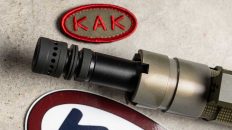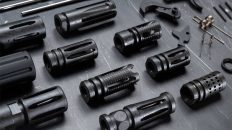The AR-15 rifle is a versatile and popular firearm known for its customizable features. One of the key components that you’ll find on many AR-15s is the flash hider. But what exactly does a flash hider do? And why is it an important consideration for AR-15 owners?
In this comprehensive guide, we’ll explore everything you need to know about AR-15 flash hiders. From their function and benefits to different types and installation methods, we’ve got you covered. Whether you’re a seasoned shooter or new to the AR-15 platform, understanding flash hiders is essential for optimizing your shooting experience.
Our article dives deep into the science behind flash hiders, explaining how they reduce muzzle flash, recoil, and noise. We also touch upon the legal considerations and regulations regarding flash hiders, ensuring you stay compliant with local laws. Additionally, we provide practical tips on choosing the right flash hider for your specific needs and preferences.
Ready to become an expert on AR-15 flash hiders? Let’s get started!
What is an AR-15 flash hider?
The AR-15 is a versatile and highly customizable rifle, with various components designed to improve performance and adapt to different shooting environments. One key component that enhances shooting in low-light conditions is the flash hider. Also known as a flash suppressor, this muzzle device is attached to the muzzle to reduce the visible flash that occurs when the firearm is discharged.
In addition to attachments like the flash hider, the upper receiver of the AR-15 plays a crucial role in the firearm’s functionality. Components within the upper receiver, such as the bolt carrier group and charging handle, are essential for optimizing the rifle’s performance.
Muzzle flash is the bright burst of light that is emitted from the barrel of a firearm when it is discharged. This flash is caused by the ignition of the gunpowder and the subsequent explosion that propels the bullet forward. While muzzle flash is a natural byproduct of the firing process, it can be problematic in certain situations, such as when shooting in low-light conditions or for tactical applications where maintaining stealth is crucial.
The flash hider works by redirecting and dispersing the hot gases that are expelled from the barrel, effectively reducing the intensity and visibility of the muzzle flash. This not only enhances the shooter’s visibility and situational awareness but also helps to preserve their night vision, which can be crucial in low-light environments. Additionally, flash hiders can help to reduce the perceived recoil of the firearm, making it easier to maintain control and accuracy during rapid-fire scenarios.
The importance of using a flash hider on an AR-15
Owning an AR-15 rifle comes with a certain level of responsibility, and one of the key considerations for AR-15 owners is the use of a flash hider. While the AR-15 is a highly customizable platform, the flash hider is an essential component that should not be overlooked.
The primary reason for using a flash hider on an AR-15 is to enhance the shooter’s safety and situational awareness. When a firearm is discharged, the muzzle flash can be blinding, especially in low-light conditions. This can temporarily impair the shooter’s vision, making it more difficult to acquire and engage additional targets or assess the surrounding environment. By using a flash hider, the shooter can mitigate this issue and maintain a higher level of control and awareness during the shooting process.
Another important consideration is the legal aspect of using a flash hider on an AR-15. In some jurisdictions, the use of a flash hider may be subject to specific regulations or restrictions. It is crucial for AR-15 owners to familiarize themselves with the local laws and regulations regarding the use of flash hiders to ensure they are in compliance and avoid any legal issues. By understanding the legal landscape, AR-15 owners can make informed decisions about the use of flash hiders and ensure they are operating their firearms within the bounds of the law.
How does an AR-15 flash hider work?
The science behind how an AR-15 flash hider works is quite fascinating. When a firearm is discharged, the ignition of the gunpowder creates a high-pressure, high-temperature explosion that propels the bullet forward. This explosion also produces a significant amount of hot gases, which are expelled from the barrel of the firearm, resulting in the muzzle flash.
The primary function of a flash hider is to redirect and disperse these hot gases, effectively reducing the intensity and visibility of the muzzle flash. This is achieved through a combination of design features and aerodynamic principles. The flash hider typically features a series of baffles, ports, or other specialized components that are engineered to break up and divert the high-pressure gases as they exit the barrel.
By redirecting and dispersing the hot gases, the flash hider helps to reduce the overall size and brightness of the muzzle flash. This not only enhances the shooter’s visibility and situational awareness but also helps to preserve their night vision, which can be crucial in low-light environments. Additionally, the design of the flash hider can also help to reduce the perceived recoil of the firearm, making it easier to maintain control and accuracy during rapid-fire scenarios.
Different types of AR-15 flash hiders
When it comes to AR-15 flash hiders, there is a wide range of options available on the market, each with its own unique design and features. Understanding the different types of flash hiders can help AR-15 owners make an informed decision when choosing the right one for their specific needs and preferences.
One of the most common types of AR-15 flash hiders is the linear flash hider. These muzzle devices are designed to redirect the muzzle flash forward, away from the shooter’s line of sight. Linear flash hiders often feature a cylindrical or conical shape, with a series of ports or baffles that help to disperse the hot gases. These flash hiders are generally effective at reducing muzzle flash while maintaining a relatively compact profile.
Another popular type of AR-15 flash hider is the concentric flash hider. These devices feature a more complex design, with multiple concentric rings or chambers that work together to break up and redirect the muzzle flash. Concentric flash hiders are often more effective at reducing muzzle flash than their linear counterparts, but they may also be slightly larger in size and have a more pronounced appearance on the rifle.
In addition to these two main types, there are also specialized flash hiders designed for specific applications or purposes. For example, some flash hiders are optimized for suppressor compatibility, while others may be designed to minimize noise or recoil. Ultimately, the choice of flash hider will depend on the shooter’s specific needs, preferences, and the intended use of the AR-15 rifle.
Choosing the right flash hider for your AR-15
When it comes to choosing the right flash hider for your AR-15, there are several factors to consider. The selection process should take into account the specific needs and requirements of the shooter, as well as the intended use of the firearm.
One of the primary considerations when choosing a flash hider is the level of muzzle flash reduction that is required. Some shooters may prioritize maximum flash suppression, while others may be more concerned with maintaining a compact profile or ensuring compatibility with other accessories, such as suppressors. Understanding the specific conditions and environments in which the AR-15 will be used can help guide the selection process.
Another important factor to consider is the overall design and aesthetics of the flash hider. While function should always take precedence, many AR-15 owners also value the appearance of their firearm and may choose a flash hider that complements the overall look and style of their rifle. Additionally, the weight and balance of the flash hider can also be a consideration, as heavier or longer devices may affect the handling and maneuverability of the AR-15.
When selecting a flash hider, it is also essential to ensure that it is compatible with the specific make and model of the AR-15 rifle. Some flash hiders may require specialized mounting hardware or may not fit properly on certain barrel configurations. Consulting with a qualified gunsmith or reviewing the manufacturer’s recommendations can help ensure a proper and secure fit.
Installation and maintenance of AR-15 flash hiders
Installing and maintaining an AR-15 flash hider is a straightforward process, but it is essential to follow the proper procedures to ensure the safety and functionality of the firearm.
The installation of a flash hider typically involves threading the device onto the muzzle of the AR-15 rifle. This process requires the use of specialized tools, such as a barrel wrench or armorers’ wrench, to properly tighten the flash hider and ensure a secure fit. It is crucial to follow the manufacturer’s instructions and guidelines to ensure the flash hider is installed correctly and does not interfere with the rifle’s operation.
Proper maintenance of an AR-15 flash hider is also essential to ensure its continued effectiveness and longevity. This includes regularly inspecting the flash hider for any signs of wear or damage, such as cracks, dents, or loose fittings. Additionally, it is recommended to clean the flash hider periodically, using a suitable cleaning solvent and a soft-bristled brush to remove any accumulated carbon or debris.
It is important to note that the installation and maintenance of an AR-15 flash hider should only be performed by individuals who are knowledgeable and experienced in firearm maintenance and repair. Attempting to install or modify a flash hider without the proper training and tools can potentially result in damage to the firearm or even pose a safety risk to the shooter or others.
Legal considerations for AR-15 flash hiders
When it comes to the use of AR-15 flash hiders, there are several legal considerations that owners must be aware of. The regulations and restrictions surrounding flash hiders can vary significantly depending on the jurisdiction, and it is crucial for AR-15 owners to familiarize themselves with the applicable laws and regulations in their area.
In some regions, the use of flash hiders on firearms may be subject to specific restrictions or even outright bans. These regulations can be driven by a variety of factors, such as concerns over the potential for increased lethality or the desire to maintain public safety. It is essential for AR-15 owners to thoroughly research and understand the legal landscape before installing or using a flash hider on their rifle.
In addition to local and state-level regulations, there may also be federal laws or guidelines that govern the use of flash hiders on firearms. The National Firearms Act (NFA), for example, may classify certain types of flash hiders as “destructive devices,” which may require additional licensing, registration, or compliance measures. Failure to comply with these regulations can result in serious legal consequences, including fines or criminal charges.
It is crucial for AR-15 owners to consult with local law enforcement, legal professionals, or reputable firearms organizations to ensure they are in full compliance with all relevant laws and regulations regarding the use of flash hiders. By staying informed and adhering to the applicable rules and guidelines, AR-15 owners can avoid legal issues and ensure they are using their firearms responsibly and safely.
Common misconceptions about AR-15 flash hiders
Despite the widespread use of flash hiders on AR-15 rifles, there are still several common misconceptions and misconceptions that exist around these devices. Understanding and addressing these misconceptions can help to provide a more accurate and informed perspective on the role and function of AR-15 flash hiders.
One common misconception is that flash hiders are primarily used for tactical or military applications, and have no place in civilian or recreational shooting. However, the reality is that flash hiders serve an important purpose for all AR-15 owners, regardless of their intended use for the firearm. By reducing muzzle flash, flash hiders can enhance the shooter’s visibility and situational awareness, which is valuable in a wide range of shooting scenarios, from home defense to target practice.
Another misconception is that flash hiders are primarily used to conceal the shooter’s location or to evade law enforcement. While it is true that flash hiders can help to reduce the visibility of the muzzle flash, this is not their primary purpose. The primary function of a flash hider is to improve the shooter’s safety and performance, not to enable nefarious activities.
Finally, some individuals may mistakenly believe that flash hiders are illegal or heavily regulated in all jurisdictions. While it is true that the legality and regulations surrounding flash hiders can vary depending on location, it is important to recognize that they are legal and commonly used accessories for AR-15 rifles in many parts of the world. By understanding and dispelling these misconceptions, AR-15 owners can make more informed decisions about the use and selection of flash hiders for their firearms.
The benefits of using an AR-15 flash hider
Using an AR-15 flash hider provides a range of benefits that can significantly enhance the shooting experience and overall performance of the firearm. These benefits extend beyond just reducing the visible muzzle flash, and can have a positive impact on the shooter’s safety, accuracy, and overall effectiveness.
One of the primary benefits of using an AR-15 flash hider is the improvement in the shooter’s visibility and situational awareness. By reducing the intensity and visibility of the muzzle flash, the flash hider helps to preserve the shooter’s night vision and allows them to maintain a clear view of their surroundings. This is especially important in low-light conditions or tactical scenarios where maintaining situational awareness is crucial.
In addition to enhancing visibility, the use of an AR-15 flash hider can also help to reduce the perceived recoil of the firearm. The design of the flash hider redirects and disperses the hot gases expelled from the barrel, which can help to mitigate the felt recoil experienced by the shooter. This can lead to improved accuracy and control, particularly during rapid-fire or rapid-target acquisition scenarios.
Another significant benefit of using an AR-15 flash hider is the potential for reduced noise levels. While the flash hider is not a true suppressor, it can help to muffle the sound of the gunshot to some degree. This can be particularly useful in environments where noise discipline is important, such as in hunting or tactical applications.
Overall, the use of an AR-15 flash hider can provide a range of tangible benefits that can enhance the shooting experience and improve the overall performance of the firearm. By understanding these benefits and selecting the right flash hider for their specific needs, AR-15 owners can optimize their shooting experience and ensure the safe and responsible use of their firearms.
Conclusion
In conclusion, the AR-15 flash hider is an essential component that plays a crucial role in the performance and safety of the rifle. By reducing muzzle flash, improving visibility, and mitigating recoil, flash hiders provide a range of benefits that can enhance the shooting experience for AR-15 owners.
Throughout this comprehensive guide, we have explored the science behind how flash hiders work, the different types of flash hiders available, and the important considerations when choosing the right one for your AR-15. We have also discussed the legal landscape surrounding flash hiders and addressed common misconceptions to provide a more informed perspective on their use.
Ultimately, the decision to use a flash hider on an AR-15 should be based on a thorough understanding of the benefits, as well as the specific needs and requirements of the shooter. By staying informed and making responsible choices, AR-15 owners can optimize the performance and safety of their firearms, while ensuring they are in full compliance with all applicable laws and regulations.





Add comment